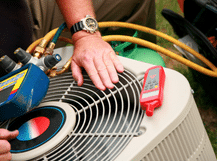When is it time to replace your HVAC system?
Your HVAC system is one of the biggest investments you will make in your home, so you want it to get the most out of it while it’s still working. But hanging onto your system for too long can leave you with higher energy bills and poor indoor air quality. So how do you know if your current HVAC system has overstayed its welcome? If your system is starting to age and you’ve been wondering if it’s time to replace, we’ve got several signs that may indicate investing in a replacement is a better bet.
An aging system
The first sign to look for is really about the age of your system. The Department of Energy recommends replacing your HVAC system every 10-15 years. As your system ages, the individual components will begin to fail or deteriorate (depending on how often you use your system and how often it’s maintained by an HVAC technician). If your system is reaching the 10+ year mark, it may be time to start mulling over when to replace.
Higher energy bills and when to replace the system
Another sign it might be time to replace is increasing energy bills. As your HVAC system ages, efficiency tends to decline especially if you have not had your equipment maintained at least once per year. Over time, you can expect your efficiency to decrease 5-10% as your system ages. While seasonal energy costs can fluctuate from month-to-month, the same month from different years should be about the same. Compare this month’s bill to your bill at this time last year to see if your costs are increasing.
Your home isn’t staying a consistent temperature
Aging HVAC systems will struggle to keep your home at a consistent temperature. This can be a sign of a variety of issues that include: damaged thermostat, low fluid levels, clogged filters, cracked ducts, and serious damage to components like motors and air handlers. If you notice this symptom, it may be time to replace – but it’s a good idea to have a trained HVAC professional inspect it first.
More dust bunnies
That’s right, if you’ve been noticing an unusual number of dust bunnies running around your home – it may be time to replace. Your HVAC system is responsible for providing proper ventilation. When it’s in working order, it should improve your indoor air quality by removing dust from the air and keeping humidity under control. If you notice more dust in the air, it’s a good time to have it checked out to determine if a replacement is on the horizon. You’ll also want to pay attention to any unusual smells or sounds. Strange smells could just be dust burning off your systems, but it’s always wise to check them out. As far as sounds go, if you hear any strange noises like grinding or squealing. For both smells and sounds, we recommend having your system inspected immediately and asking your HVAC technician if it may be time to replace.
Replace it when there is Poor Air Quality
Your HVAC system can also improve your indoor air quality. As your system starts to age, your air quality can decrease. Some signs your indoor air quality needs some attention or you may need to think about replacing include: mold, mildew, dust, and unusually high humidity. If you notice any of these signs, contact your HVAC professional and start considering a replacement down the road.
Rising repair costs
Every HVAC system needs repair from time to time. As your system ages, you’ll notice a greater need to call for service appointments and repair components. When the components you need to replace are major parts, your repair bills can skyrocket. If you’ve noticed higher repair bills at a greater frequency, then replacing your system may be a better investment.
When you notice any of these signs or when these signs are becoming a more frequent occurrence in your home, then it may be time to replace your HVAC system. If you’re still on the fence on whether it’s time to replace, we’d love to help! Simply call our office to make an appointment, and one of our HVAC technicians can inspect your system and help you determine if you’re ready for a replacement.
 Book Online
Book Online

